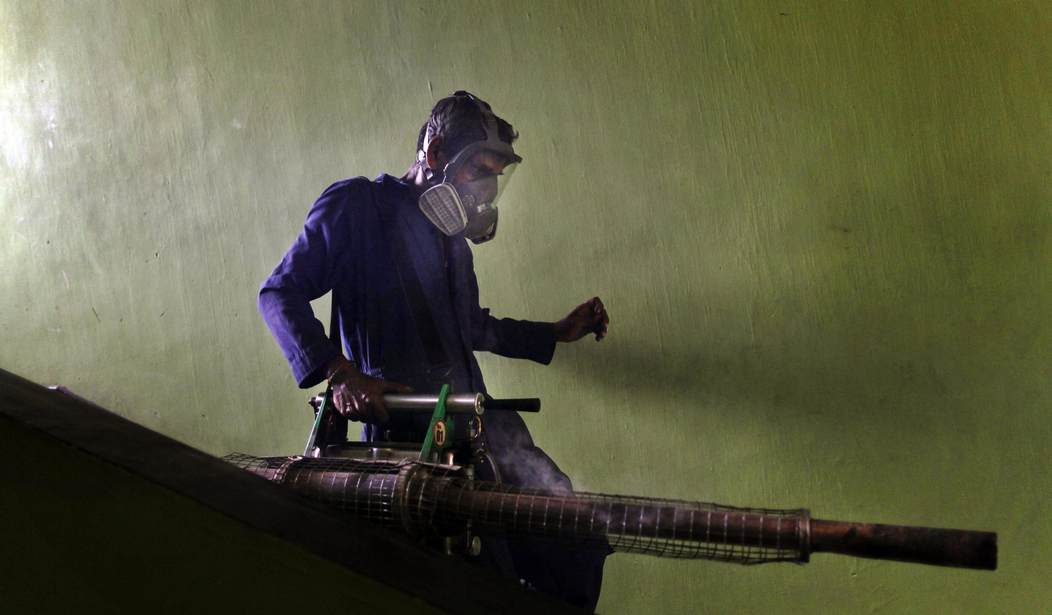The dangers of technological complexity were highlighted after authorities in the Philippines suspended the administration of the dengue fever vaccine Dengvaxia when manufacturer Sanofi announced that while it would help those who once had the disease it might produce an even more severe attack in those who were infected for the first time. The company said:
Based on up to six years of clinical data, the new analysis … confirmed that Dengvaxia provides persistent protective benefit against dengue fever in those who had prior infection. For those not previously infected by dengue virus, however, the analysis found that in the longer term, more cases of severe disease could occur following vaccination upon a subsequent dengue infection.
“These findings highlight the complex nature of dengue infection. We are working with health authorities to ensure that prescribers, vaccinators and patients are fully informed of the new findings, with the goal of enhancing the impact of Dengvaxia in dengue- endemic countries.” said Dr. Su-Peing Ng, Global Medical Head, Sanofi Pasteur.
Unfortunately the warning came too late. Health authorities had already vaccinated 733,000 children with Dengvaxia before the warning. Philippine authorities had eagerly jumped at a “landmark” program to become “the first country to start using it on a mass scale” after it had been clinically trialed in 10 countries — 5 in Asia and 5 in Latin America — with apparent success. Now all the chastened bureaucrats could belatedly do was glumly announce preparations for a “worst-case scenario” should a spike in the disease occur.
The bureaucrats had understandably relied on rational ignorance, in this case the prestige of the WHO and French pharmaceuticals, to reach a decision about the safety of a technology. But what rational ignorance hides is complexity. Behind the scenes there was dissent over the mechanism by which vaccine worked of which the bureaucrats were unaware. Even as Dengvaxia passed its trials some researchers feared the vaccine could trigger antibodies in a “naïve subject” that would weaken them against a second exposure, a process called ADE. “Protective antibodies can turn double agent, teaming up with the dengue virus to make an infection more severe, even life-threatening.” Those fears might have proved correct.
What the vaccine might actually have done was kick in the door for those who have never had dengue before. “In an email correspondence, Sanofi Pasteur spokesperson Laurence Bollack held back from admitting the vaccine caused ADE. … Halstead and Russell disagreed. Using Sanofi’s phase 3 data, they published a study in Vaccine last February showing that during the 3 years following immunization among seronegative children, dengue hospitalization rate was significantly higher among vaccinees than controls. For children without prior dengue exposure, the vaccine acts as a priming dose of the virus.” No one imagines Sanofi knew this would happen. It was just one of those things humans cannot foresee.
Today politicians are increasingly under pressure to unleash complex technologies on millions of people. With so many problems facing the world the market for magic bullets has never been greater. Perhaps one of the most dramatic of such proposals was Atlantropa, “a gigantic engineering and colonization idea devised by the German architect Herman Sörgel in the 1920s … [whose] central feature was a hydroelectric dam to be built across the Strait of Gibraltar, which would have provided enormous amounts of hydroelectricity and would have led to the lowering of the surface of the Mediterranean Sea by up to 200 metres (660 ft), opening up large new lands for settlement, for example in the Adriatic Sea.”
Like many such gigantic projects Atlantropa was motivated idealism, in this case the desire to head off a second European war. “Sörgel saw his scheme, projected to take over a century, as a peaceful European-wide alternative to the Lebensraum concepts that later became one of the stated reasons for Nazi conquest of new territories. Atlantropa would provide land and food, employment, electric power, and most of all, a new vision for Europe and neighbouring Africa.” In retrospect we now suspect that despite its good intentions barring the Straits would probably have set off a cascade of environmental consequences no one in the mid-20th century could foresee. Perhaps it might not have stopped Nazism at all.
https://youtu.be/Uzdxf_5e-JU
The experience of the Soviets, the only rivals to the Nazis for engineering gigantism, is instructive. In its haste to improve agriculture, USSR implemented irrigation projects that destroyed the Aral Sea. “The Great Plan for the Transformation of Nature, also known as Stalin’s plan for the transformation of nature, was proposed by Joseph Stalin in the Soviet Union in the second half of the 1940s, for land development, agricultural practices and water projects to improve agriculture in the nation.” The Plan needless to say, did not work.
Yet the mind-boggling goals of the German superproject and even Stalin’s Great Plan pale in comparison to the biggest engineering undertaking of our age: the Paris Climate Agreement. With a 195 signatories the goal of the agreement is nothing less than the modification of the weather system of the entire planet, a much bigger deal than simply damming up the Straits of Gibraltar. It sails serenely on. Most political leaders have signed on to the accord on the same basis that Philippine health authorities agreed to Dengvaxia: rational ignorance. Presidents and prime ministers, incapable of independently judging the technological soundness of the Paris Agreement, must rely instead scientific consensus that it’s good.
But as with Dengvaxia reliance rational ignorance conceals the controversies within the technology itself. Swedish, Japanese, American and New Zealand researchers recently found that once respondents realized the Paris Agreement actually meant climate engineering they were much less confident of a predictable outcome. As soon as Paris stopped being a magic bullet and descended to the level of engineering attitudes changed dramatically.
When the moderators first mentioned climate engineering, recurrent initial reactions were expressed by using the terms ‘scary’, ‘risky’ and ‘science fiction’. With a few exceptions—particularly in some of the Japanese groups—participants were largely critical of the prospect of climate engineering, sometimes reacting with disbelief or nervous laughter at the idea. One common theme in the focus group discussions related to the risk of unintended side effects as a consequence of climate engineering. Participants claimed that introducing climate engineering might lead to humankind’s losing control of what it had started; despite good intentions to alleviate the impacts of climate change, deliberate large-scale manipulation of the global climate might have unforeseen negative consequences, making the situation even worse, especially for already vulnerable groups of people. In particular, participants expressed their fear that climate engineering might cause changes in ecosystem balance.
Technological risk is now an part and parcel of 21st century public policy decision-making. It is exacerbated by the fact that the relationship of the public to technology is increasingly one of the uncomprhending towards magic. While the public awarness of risk is most prevalent in the field of artificial intelligence due to the high profile warnings of Elon Musk, Bill Gates and Stephen Hawking, the dengue fiasco shows risk is also present in biology and medicine — and in other fields too. From giant sized batteries to cheap Wifi from orbit we are likely to see more, not fewer offers of magic solutions to politicians. Here are but a few of the technologies which will come for their consideration.
Artificial photosynthesis and carbon capture for producing biofuels – If technical hurdles can be overcome, such developments might contribute to the future adoption of carbon capture systems, and provide sustainable sources of commodity chemicals and fuel.
Enhanced photosynthesis for agricultural productivity – Synthetic biology may hold the key to increasing yields on currently farmed land – and hence helping address food security – by enhancing photosynthesis and reducing pre-harvest losses, as well as reducing post-harvest and post-consumer waste.
Synthetic gene drives – Gene drives promote the inheritance of preferred genetic traits throughout a species, for example to prevent malaria-transmitting mosquitoes from breeding. However, this technology raises questions about whether it may alter ecosystems, potentially even creating niches where a new disease-carrying species or new disease organism may take hold.
Human genome editing – Genome engineering technologies such as CRISPR/Cas9 offer the possibility to improve human lifespans and health.
Some of them will work and some of them unfortunately will not. More than a few of them are undoubtedly dangerous. Is the world ready for the Singularity or will it find out about the problem, like the hapless Filipino health bureaucrats, only after 733,000 children have already been vaccinated? Maybe the last word belongs to the late Michael Crichton. He warned his readers that complexity could play tricks. “God created dinosaurs. God destroyed dinosaurs. God created Man. Man destroyed God. Man created dinosaurs. Dinosaurs eat man…Woman inherits the earth.”
Follow Wretchard on Twitter
For a list of books most frequently purchased by readers, visit my homepage.
Support the Belmont Club by purchasing from Amazon through the links below.
Books:
The Fleet at Flood Tide: America at Total War in the Pacific, 1944-1945, by James D. Hornfischer. From the historian who has been acclaimed as “doing for the Navy what popular historian Stephen Ambrose did for the Army,” here is an unprecedented account of the extraordinary World War II air, land, and sea campaign that brought the U.S. Navy to the apex of its strength and marked the rise of the United States as a global superpower.
The Big Stick: The Limits of Soft Power and the Necessity of Military Force, by Eliot A. Cohen. In the book, Cohen argues that hard power remains essential for American foreign policy. He explains that American leaders must learn to use hard power in new ways and for new circumstances. The rise of a well-armed China, Russia’s conquest of Crimea and eastern Ukraine, nuclear threats from North Korea and Iran, and the spread of radical Islamist movements like ISIS are some of the key threats to global peace. If the US fails to accept its role as the guardian of a stable world order, we run the risk of unleashing disorder, violence and tyranny on a scale not seen since the 1930s.
The Gene: An Intimate History, by Siddhartha Mukherjee. An epic, moving history of a scientific idea coming to life, by the Pulitzer Prize-winning author of The Emperor of All Maladies. But woven through it, like a red line, is an intimate history – the story of Mukherjee’s own family and its recurring pattern of mental illness, reminding us that genetics is vitally relevant to everyday lives.
Greater Gotham: A History of New York City from 1898 to 1919 (The History of NYC Series) 1st Edition, by Mike Wallace. Called “the new gold standard of urban history”, this 988-page book covers literally every aspect of the city during the period, with facts, figures, maps, pictures, newspaper cartoons, and anecdotes. A fascinating and rich compendium.
For a list of books most frequently purchased by readers, visit my homepage.
Did you know that you can purchase some of these books and pamphlets by Richard Fernandez and share them with your friends? They will receive a link in their email and it will automatically give them access to a Kindle reader on their smartphone, computer or even as a web-readable document.
The War of the Words, Understanding the crisis of the early 21st century in terms of information corruption in the financial, security and political spheres
Rebranding Christianity, or why the truth shall make you free
The Three Conjectures, reflections on terrorism and the nuclear age
Storming the Castle, why government should get small
No Way In at Amazon Kindle. Fiction. A flight into peril, flashbacks to underground action.
Storm Over the South China Sea, how China is restarting history in the Pacific
Tip Jar or Subscribe or Unsubscribe to the Belmont Club










Join the conversation as a VIP Member